US Navy Aircraft markings and
designations
From 1917 to 1947
This is the roundel for US Navy aircraft first defined in May 1917. It was
to be placed on top of the upper wing and the bottom of the lower wing near each
wingtip. Roundels were also to be placed on each side of the fuselage.
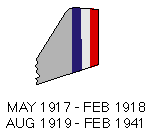
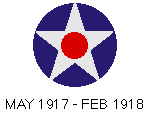 Aircraft
remaining inside the United States proper had tail marking composed of three
vertical stripes, painted in blue, white and red (with blue at the rudder hinge
and red at the end. This marking was already in use on naval aircraft
prior to this, but was officially standardized when the roundel was added.
US aircraft in Europe reversed the order of stripes on the rudder.
Aircraft
remaining inside the United States proper had tail marking composed of three
vertical stripes, painted in blue, white and red (with blue at the rudder hinge
and red at the end. This marking was already in use on naval aircraft
prior to this, but was officially standardized when the roundel was added.
US aircraft in Europe reversed the order of stripes on the rudder.
Once in Europe, an attempt was made to conform to allied national
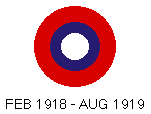 marking
standards. The star was removed and a red blue and white roundel replaced
the blue disk, star and red center. Since the major allied forces
(British, French, and Russian) all used red, white, and blue in some form in
their roundels, confusion did occur.
marking
standards. The star was removed and a red blue and white roundel replaced
the blue disk, star and red center. Since the major allied forces
(British, French, and Russian) all used red, white, and blue in some form in
their roundels, confusion did occur.
Following the end of the war, the national marking
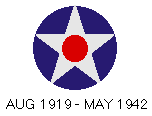 reverted
to the uniquely American white star on a blue disk with a red disk in the
center. The rudder markings also returned to the former blue white and red
(shown above).
reverted
to the uniquely American white star on a blue disk with a red disk in the
center. The rudder markings also returned to the former blue white and red
(shown above).
aircraft Serial numbers began to be painted on the tail/vertical stabilizer or
tail fin. In navy terms, since aircraft fell under the Navy's Bureau of
aeronautics, it came to be
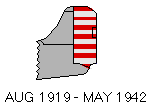 called
the bureau number (abbreviated buno).
called
the bureau number (abbreviated buno).
By 1923, these extra markings were standardized with the squadron identification
markings in 12" high black block letters. The letters were 1st - a number
designating the squadron (Air station aircraft were marked with an abbreviation
of the air station name here), 2nd - a letter designating the mission of the
aircraft/squadron, 3rd - the number aircraft in the squadron. These
characters were separated by hyphens. aircraft assigned a combat mission
had the air station abbreviation added behind the squadron mission letter.
USMC aircraft placed the mission designator in a circle.
Added was the requirement for "US Navy" to be added on the fuselage aft of the
squadron markings. oddly, the USMC was not required to mark their aircraft
similarly until 1925.
In 1925, USMC aircraft were to leave a place for the USMC emblem (the eagle,
globe , and anchor). The 1925 markings instruction added three 4" color
bands to the propeller tips - insignia red at the tip, bright yellow, and
insignia blue.
June 1931's markings instruction finally require "US Marines" to be painted on
the sides of the aircraft fuselage. Also included were further squadron
markings. Twenty inch wide color bands were assigned to each of the six
sections in a squadron. The section leader (each section was composed of
three aircraft) had a
band completely
encircle the fuselage and engine cowling. The number 2 aircraft had a
half-band on the upper part of the fuselage, while the number 3 aircraft had a
band on the lower half of the fuselage. Sections were recognized by the
color - section 1
royal red, section 2 white, section 3
true blue, section
4 black, section 5 willow green, and section 6 lemon yellow.
This section color coding added
chevrons of
the same color be painted on the upper wing surface pointing forward.
Distinguishing colors (used to separate squadron aircraft from different
squadrons operating together) was also authorized (but not defined or
restricted). "US Navy" or "US Marines" was required to be painted on the
lower wing surfaces. Training aircraft were excluded. The lower wing
marking requirements were canceled in 1932.
1933 authorized a small number being painted on the engine cowl. This was
the intra-squadron aircraft number.
The preparations for eventual war in 1937 brought broader changes and
standardization. Each aircraft carrier and its assigned air group were
assigned colors for marking the tail (or empennage) of the aircraft on board.
Patrol squadron, patrol wings, and observation squadrons assigned to battleships
and cruisers were identified by empennage markings. These could be solid,
horizontal, or vertical stripes, or checkerboard. These colors were
assigned by Commander in Chief (CinC), US Fleet (a position that ended with the
reorganization in 1947 to create the Department of Defense).
in late 1940 and early 1941, more marking changes were issued. Carrier Air
Group Commanders (called CAGs) were to have 14" diagonal bands painted forward
of the service markings in the color of the hosting air craft carrier. The
title "Commander (name of assigned carrier)
Group" was to be painted on each side of the fuselage.
The national insignia were now required to be on each side of the fuselage, but
now only on the upper left and lower right wing surfaces. "US Marines" and
"US Navy" markings were replaced with "Marine" or "Navy" painted above the
Bureau Number. Colored tail markings, engine cowl bands, chevrons,
fuselage bands, and the USMC emblem were removed. The recently added CAG
bands were included in the ban. vertical red, white and blue mark rudder
stripes were removed. All remaining color markings other than the national
emblem were to be painted in colors least contrasting to background color.
January 1942 found
rudder markings returning with the 13 horizontal red
 and white stripes
familiar in the early war movies. Following the Doolittle Raid, the red
disk was removed. This was done because the small red disk in a large
white star on a large blue disk was thought to be too easy to confuse with the
large red disk of Imperial Japanese Army and Navy aircraft. The red and
white stripes added in January were ordered removed.
and white stripes
familiar in the early war movies. Following the Doolittle Raid, the red
disk was removed. This was done because the small red disk in a large
white star on a large blue disk was thought to be too easy to confuse with the
large red disk of Imperial Japanese Army and Navy aircraft. The red and
white stripes added in January were ordered removed.
The next change was for "Operation Torch" in November 1942. Not as
noticeable as the later "D-Day" Markings, the identification marking was a
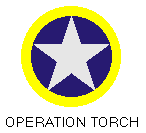 yellow
circle around the national emblem. The
Operational Order did not mention marking the emblems on the upper wing surface.
Shortly after "Operation Torch", the naval aircraft of CV-4 USS Ranger,
and CVEs USS Chenango, USS Sangamon, USS Suwannee, and USS
Santee painted over the yellow ring. US Army Air Force aircraft in
North Africa and Europe kept the yellow ring for a while.
yellow
circle around the national emblem. The
Operational Order did not mention marking the emblems on the upper wing surface.
Shortly after "Operation Torch", the naval aircraft of CV-4 USS Ranger,
and CVEs USS Chenango, USS Sangamon, USS Suwannee, and USS
Santee painted over the yellow ring. US Army Air Force aircraft in
North Africa and Europe kept the yellow ring for a while.
February 1943 found the national insignia again removed from the upper right and
lower left wing surfaces. The red, yell, and blue propeller tip markings
were removed. If the propeller was a hazard to personnel, a 4"
Orange-Yellow band was painted on the tip. Otherwise, the propeller blades
and hub were painted black.
July 1943 added white rectangles to left and right sides
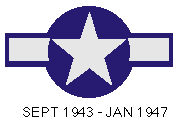 of
the blue disk. A
of
the blue disk. A
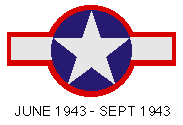 red
border stripe was added. The rectangles were based on the diameter of the
blue field. The emblem should be no more than 75% of the height of the of
the surface it was painted on. Wing emblems were to be 1/3rd of the way in
from the wing tip. Shortly there after, the red was replaced with blue.
red
border stripe was added. The rectangles were based on the diameter of the
blue field. The emblem should be no more than 75% of the height of the of
the surface it was painted on. Wing emblems were to be 1/3rd of the way in
from the wing tip. Shortly there after, the red was replaced with blue.
Following the end of open hostilities, Naval Reserve aircraft were required to
have an International Orange bands the same width of the blue border surrounding
the national Aircraft Insignia. The band was to touch but not overlap the
blue border. Later the same year (1946) a letter identification system for
all Navy and Marine Corps aircraft was adopted. Two letter groups were
assigned to each carrier, wing, group, squadron, and command that had any
aircraft. A similar system was applied to USAAF (and later USAF) aircraft.

 Aircraft
remaining inside the United States proper had tail marking composed of three
vertical stripes, painted in blue, white and red (with blue at the rudder hinge
and red at the end. This marking was already in use on naval aircraft
prior to this, but was officially standardized when the roundel was added.
US aircraft in Europe reversed the order of stripes on the rudder.
Aircraft
remaining inside the United States proper had tail marking composed of three
vertical stripes, painted in blue, white and red (with blue at the rudder hinge
and red at the end. This marking was already in use on naval aircraft
prior to this, but was officially standardized when the roundel was added.
US aircraft in Europe reversed the order of stripes on the rudder. marking
standards. The star was removed and a red blue and white roundel replaced
the blue disk, star and red center. Since the major allied forces
(British, French, and Russian) all used red, white, and blue in some form in
their roundels, confusion did occur.
marking
standards. The star was removed and a red blue and white roundel replaced
the blue disk, star and red center. Since the major allied forces
(British, French, and Russian) all used red, white, and blue in some form in
their roundels, confusion did occur. reverted
to the uniquely American white star on a blue disk with a red disk in the
center. The rudder markings also returned to the former blue white and red
(shown above).
reverted
to the uniquely American white star on a blue disk with a red disk in the
center. The rudder markings also returned to the former blue white and red
(shown above). called
the bureau number (abbreviated buno).
called
the bureau number (abbreviated buno).  yellow
circle around the national emblem. The
Operational Order did not mention marking the emblems on the upper wing surface.
Shortly after "Operation Torch", the naval aircraft of CV-4 USS Ranger,
and CVEs USS Chenango, USS Sangamon, USS Suwannee, and USS
Santee painted over the yellow ring. US Army Air Force aircraft in
North Africa and Europe kept the yellow ring for a while.
yellow
circle around the national emblem. The
Operational Order did not mention marking the emblems on the upper wing surface.
Shortly after "Operation Torch", the naval aircraft of CV-4 USS Ranger,
and CVEs USS Chenango, USS Sangamon, USS Suwannee, and USS
Santee painted over the yellow ring. US Army Air Force aircraft in
North Africa and Europe kept the yellow ring for a while. of
the blue disk. A
of
the blue disk. A
 red
border stripe was added. The rectangles were based on the diameter of the
blue field. The emblem should be no more than 75% of the height of the of
the surface it was painted on. Wing emblems were to be 1/3rd of the way in
from the wing tip. Shortly there after, the red was replaced with blue.
red
border stripe was added. The rectangles were based on the diameter of the
blue field. The emblem should be no more than 75% of the height of the of
the surface it was painted on. Wing emblems were to be 1/3rd of the way in
from the wing tip. Shortly there after, the red was replaced with blue.